Schlagwort: ‘Studium’
That’s the way to study – the rating in the CHE Ranking 2025.

The degree programs at the Faculty of Electrical Engineering and Information Technology received top feedback in Germany’s largest university ranking.
The current CHE ranking confirms that the Bachelor’s degree programmes in Electrical Engineering and Information Technology (with and without an orientation semester) and Computer Engineering are of an excellent standard. Support at the start of studies is rated particularly highly, achieving an impressive result of 15 out of 16 points. According to student feedback, they find the facilities and organisation of their studies excellent. The ranking results show that students preparing to study abroad have very positive experiences with support. The Faculty of Electrical Engineering and Information Technology received positive ratings in the fact check with regard to doctorates per professor and third-party funding per researcher. This indicates a clear focus on science. Students also express above-average satisfaction with the introduction to scientific work.
Once the field of study has been chosen, the question of which university to attend may arise. In addition to the professors’ assessment and the fact-check, this ranking includes first-hand assessments from students for prospective students.
Some of the questions that were rated on a scale of one to five stars were: ‘How broad is the content of the degree programme?’, ‘Can compulsory courses be attended without overlapping?’, and ‘Are the PCs up to date or old-fashioned?’
The CHE ranking is the most comprehensive university ranking in the German-speaking world. More than 300 universities were analysed, and over 120,000 students took part in a survey. Individual universities are compared with each other based on various criteria for each subject, and are then categorised into top, middle or bottom groups. RWTH was ranked in the top group a total of 97 times.
Each subject is analysed every three years. The results for the individual subjects are available at the website CHE Ranking 2025: The Big University Ranking.
I´m gonna be an Engineer – Team HVT
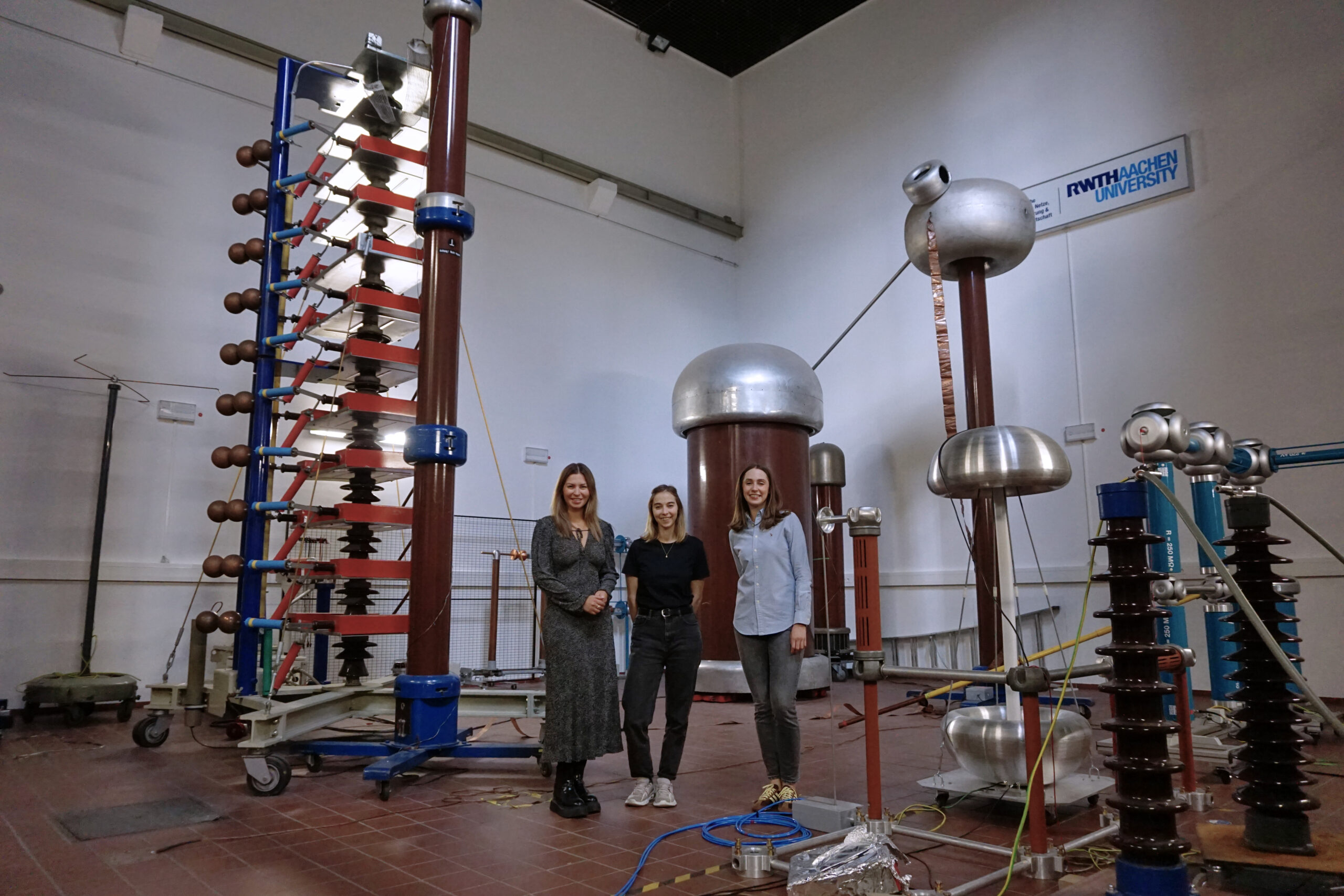
In the field, lightning strikes and other extreme events can push the power infrastructure to its limits. To ensure safe operation, tests can be carried out using high-voltage generators.
The High Voltage Technology (HVT) research and teaching unit is actively involved in developing new solutions for the energy transition. Here, three members of the team give an insight into their day-to-day work.
Through your research, you are committed to pushing the boundaries of innovation in the energy sector. But where did you start? Alexandra, what subjects were you interested in at school and what happened then?
‘My journey into the energy sector began when I was still at school. From an early age, I had a strong interest in scientific subjects, especially physics and mathematics. When I was at school, my secondary school had a direct cooperation programme with the university where I later completed my Bachelor’s degree. As part of this programme, we were able to attend additional courses after school, which allowed us to get to know different aspects and types of STEM subjects better. I had always been fascinated by physics, but I soon realised that I wanted to study engineering. What ultimately led me to electrical engineering was my desire to solve real-world problems and drive innovation.’
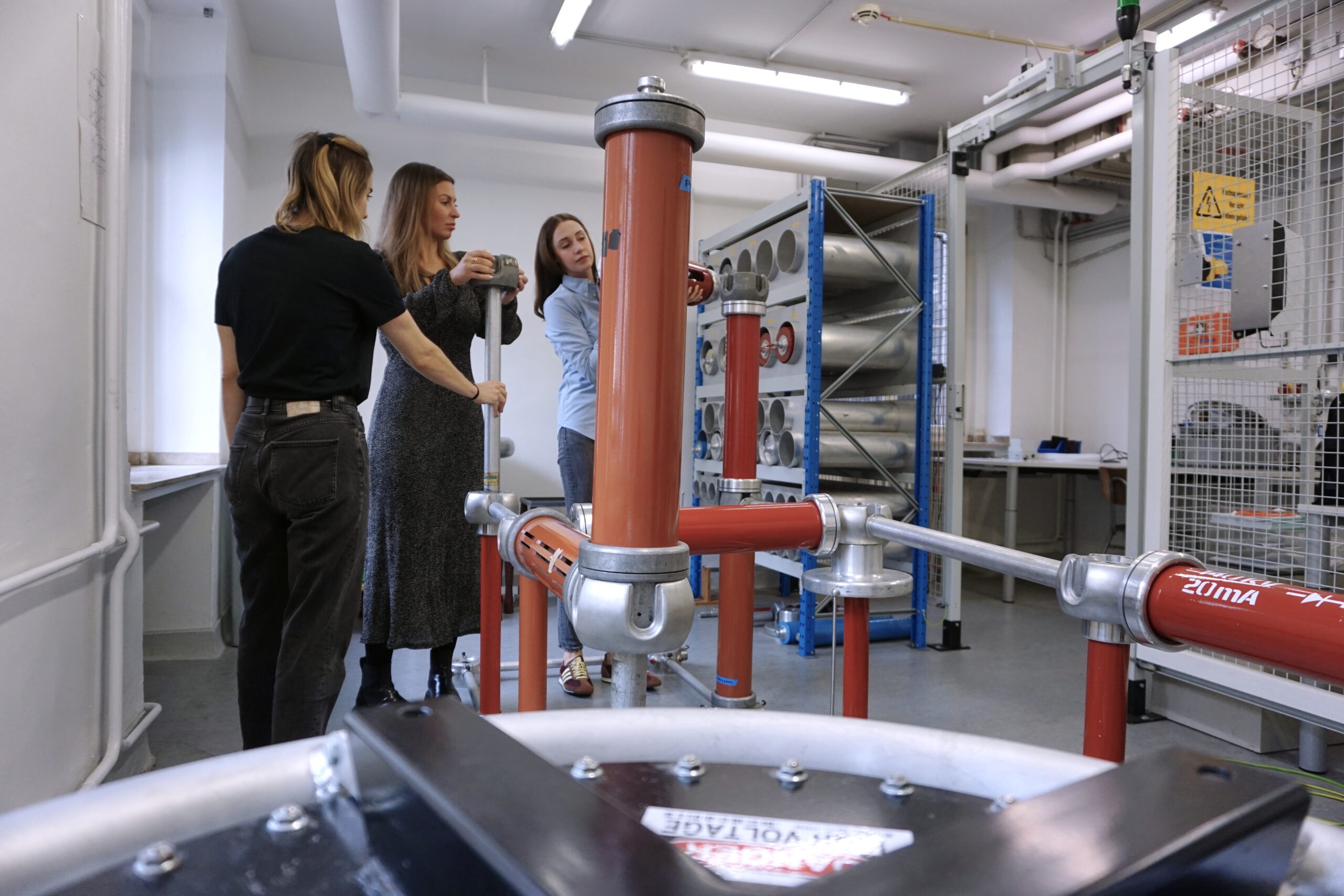
A test bench has been set up for electrical engineering and information technology students to put their theoretical knowledge to the test.
The rapid transformation of the energy system is creating new challenges. Electricity highways such as Südlink and Südostlink will transport electricity from onshore and offshore wind farms from the north to all parts of Germany. They will use high-voltage direct current (HVDC) transmission. You are researching insolation systems under direct current load. What are the advantages of direct current (DC) over alternating current (AC)? And why is a reliable isolation system so important?
‘Projects such as Südlink and Südostlink use high-voltage direct current (HVDC) to transport electricity efficiently over long distances. HVDC has the advantage over alternating current that it offers lower transmission losses, higher transmission capacities and improved grid stability. In addition, HVDC can be easily integrated into existing grids. A reliable insulation system is essential to ensure the safety and efficiency of the entire transmission system. In addition to withstanding the high loads associated with stationary power transmission, the insulation must also be able to withstand short-term transients of overvoltage. The correct functioning of the insulation system is critical to the proper operation of the entire energy system, as critical infrastructure such as power cables, converters and power transformers require a properly functioning insulation system. Our research focuses on optimising these systems to increase the reliability and lifetime of transmission networks, ultimately supporting the energy transition.’
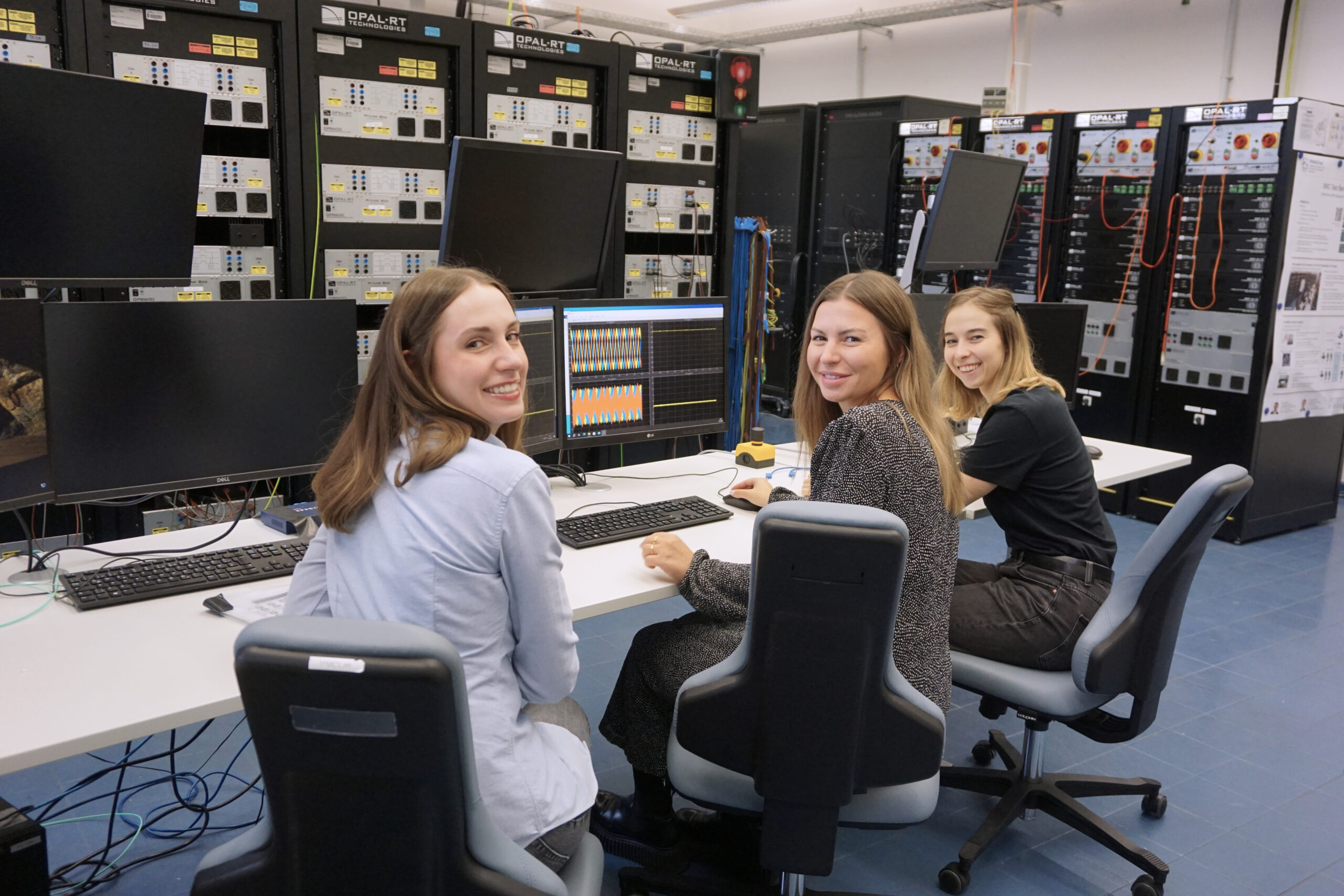
One application for the MMC test bed is the safe and ‘intelligent’ integration of electricity from offshore wind farms into the onshore transmission grid. Eight laboratory-scale modular multilevel converters (MMCs) enable the simulation of different systems and scenarios in real time, making it possible to plan the implementation of the energy transition.
In a vision of the future, we will be driving autonomous cars that we charge with renewable electricity from the ‘smart grid’. From your research perspective, what demands will be placed on the electricity grid? What groundbreaking developments are you working on? And what projects are you most excited about?
‘The electricity grid must meet many requirements to ensure a reliable and efficient supply of energy. In our research area, we work on different aspects of the energy transition, divided into the Insulation Systems, Primary Technology and Diagnostics and DC Systems teams. This allows us to cover both the ‘big picture’ of the grid and the ‘small picture’ of the critical components in the grid. With today’s focus on the new green power system of renewable energy and environmentally friendly circuit breakers, we are working on exciting projects that will enable this transformation. These include DC switches for DC systems and advanced environmentally friendly insulation systems for various applications. Another important aspect of our work is the integration of new technologies into existing systems to ensure a smooth transition. What I find particularly exciting are projects that deal with the further development and adaptation of existing equipment in the context of the energy transition. This work helps to ensure that the existing electricity system continues to operate efficiently and reliably, while at the same time driving the transition to renewable energy and modern technologies.’
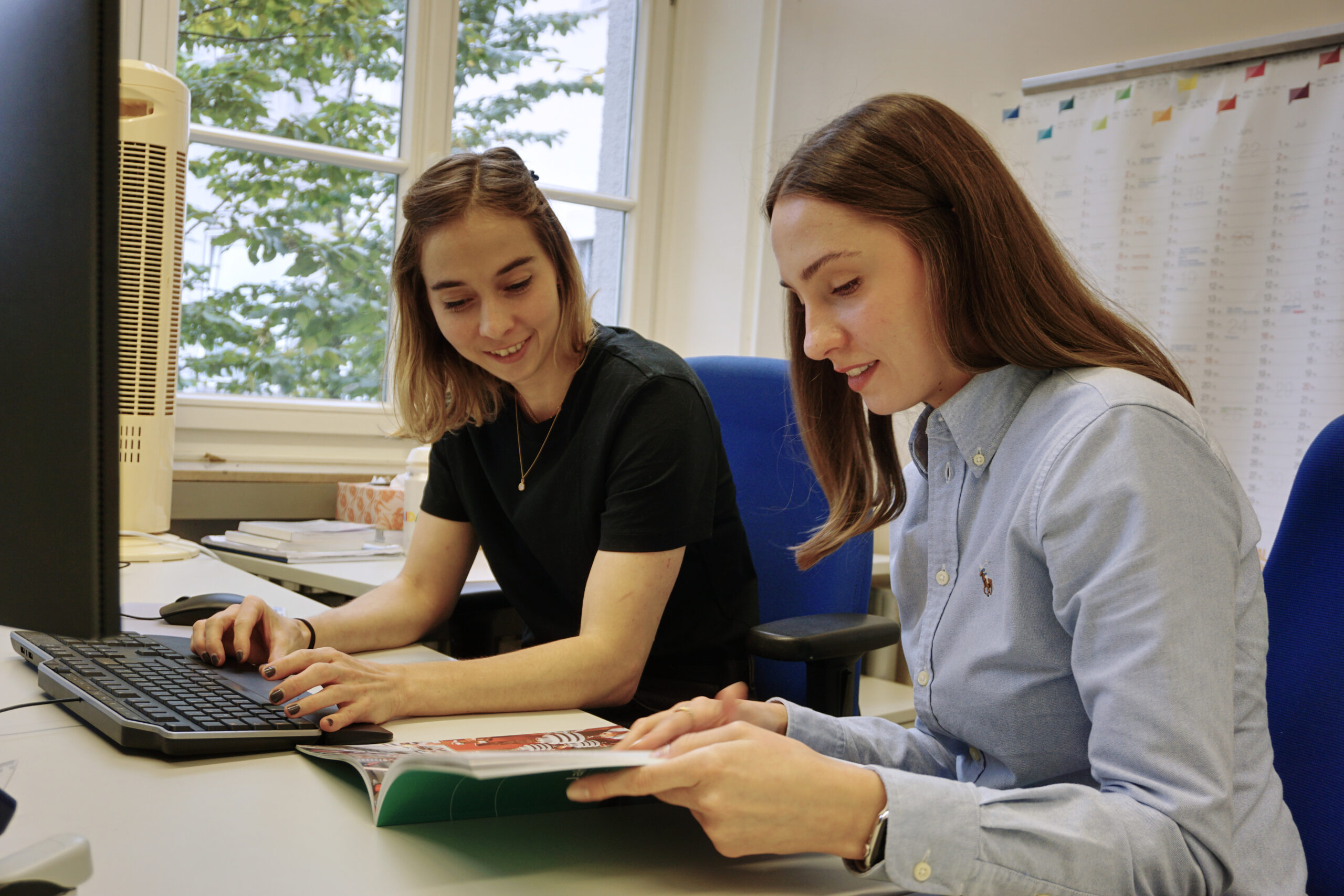
From left: Verena West is researching new types of circuit breakers as components of a meshed AC grid. Aleksandra Wiecha is researching the lifetime of insulation systems in the context of distributed energy generation and supply.
Your research will cover a broad spectrum from modern electrical systems to control and protection concepts for future power grids. You have a state-of-the-art laboratory infrastructure at your disposal. Verena, what is a typical working day like? What other aspects of the job are important? How important is teamwork and other soft skills?
‘In the mornings, I start at least an hour before I start working with the students (final year students and student assistants) in the lab. During this time, I deal with my emails and try to find time to work on my thesis topic. When the students arrive, we go through the plan for the lab day and I give them the go-ahead to start their experiments. Then I go back to my desk and work on various projects, analysing the results of experiments or working on my dissertation. If there are problems in the lab, I help out. Teamwork is very important to me, because you can’t get very far in the lab without working together. The support and guidance from experienced colleagues is very helpful. As the work as a research assistant covers many different topics, the ability to quickly familiarise yourself with new problems is also extremely important, as is good time management.’
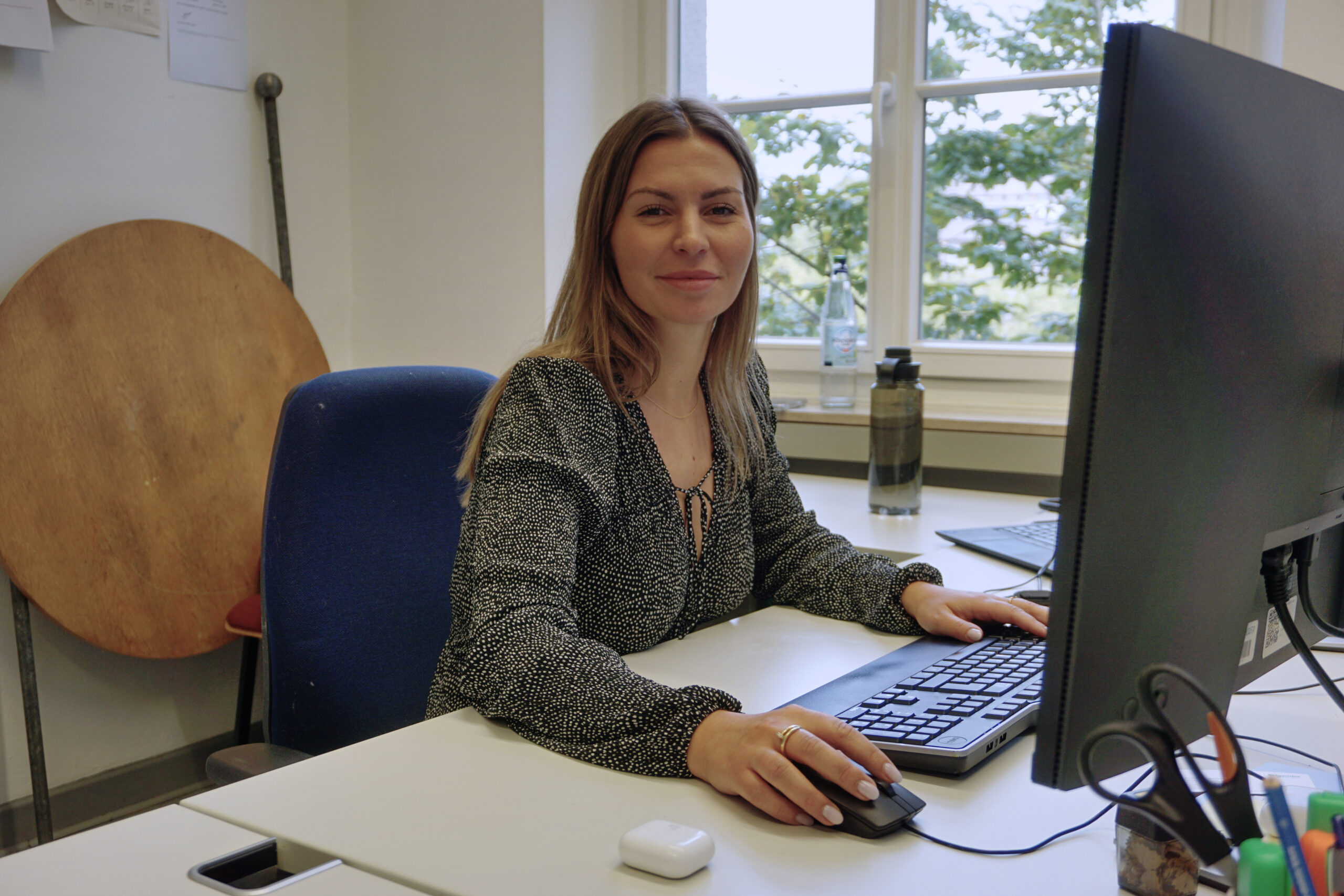
Sarah’s research focuses on the protection of AC lines in the transmission grid as the share of renewable energy increases.
Diversity and equal opportunities are core values in your team. Sarah, what does work-life balance mean to you personally and do you live it?
‘Work-life balance is a popular trend these days. In addition to my professional life, I regularly commute between my home in Bavaria and Aachen. This situation poses a particular challenge when it comes to finding the perfect balance. I have learnt that work-life balance does not necessarily mean an equal division of time between work and private life. It is more about setting priorities and making compromises in order to integrate both areas in the best possible way. It’s important to define what work-life balance means to you individually, rather than following general trends. To balance my professional and personal responsibilities, I rely on clear prioritisation and good organisation. I consciously make time for sport, activities with family and friends, travel and also periods of rest to ensure a sustainable balance. The support of my environment plays an important role in this. Of course, there are periods when one area requires more attention than the other, but overall I always strive for balance.’
Be inspired and find your own way!
On our website we inform you about our study programmes.
A work of possibilities – Team AEV
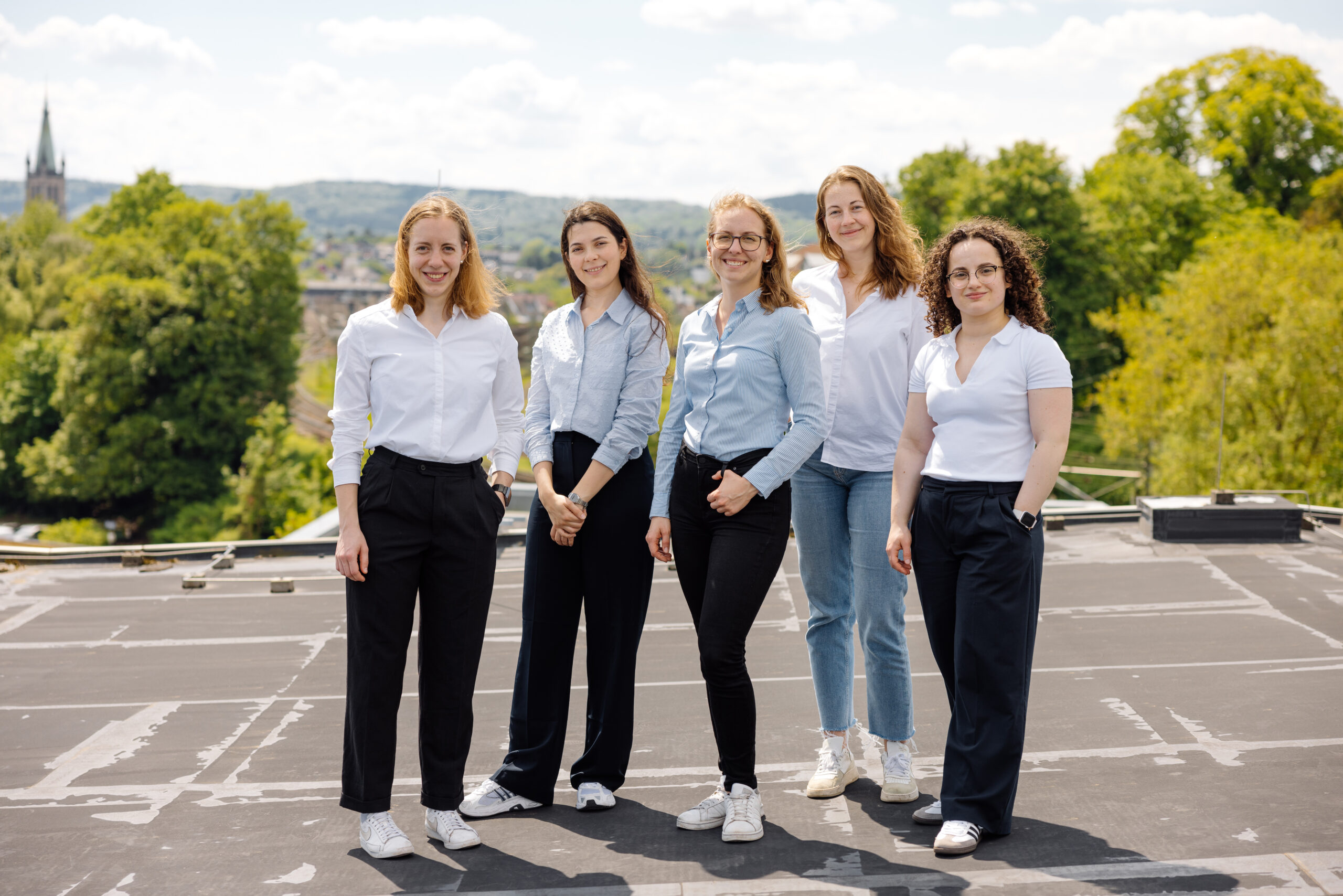
From the left: Almut Herzog, Sarra Bouchkati, Irina Zettl, Franziska Tischbein, Antigona Selimaj © Martin Braun
The Chair of Active Energy Distribution Grids at the Institute of High Voltage Equipment and Grids, Digitalization and Energy Economics (IAEW) currently employs five female researchers who demonstrate how varied and exciting a technical degree and subsequent doctorate can be.
Each has a unique educational background – from electrical and industrial engineering to physics and computer science. What they all have in common is a shared motivation: A passion for science and a desire to shape the future through technological innovation. Their topics range from the design of protection systems and cybersecurity to the use of AI in network operations. Whether simulating on the computer or experimenting in the lab, each contributes their unique knowledge and can build new expertise in previously unknown areas.
Antigona, team leader of the Resilient Grid Control Technology group, explains her motivation for studying industrial engineering with a focus on electrical engineering:
„Even at school, I was very interested in maths and physics. I was also fascinated by electrical engineering as a branch of physics, and I thought that combining it with business administration would open up excellent career opportunities.“
STEM professions are not only in high demand in many sectors, they also offer excellent career prospects. The high need for skilled professionals ensures job security and stable career prospects. These professions also open up international opportunities, whether through projects abroad or working in international teams.

Making a social contribution to the energy transition is now particularly important to Antigona. In this respect, she feels it is her responsibility to act as a role model for young women who also want to pursue a career in STEM professions:
„I would like to set a good example and encourage young women to develop their own potential.”
When it comes to doctorates, everyone agrees that they allow you to constantly learn new things and develop yourself. In addition to personal growth, this position would offer the opportunity to play an active role in shaping social development. Being active in research would therefore mean to work on precisely those projects that have the potential for meaningful change.
„Doctoral studies allow us to work on cutting-edge technological and scientific innovations,” explains Antigona.
The work of the Chair of Active Energy Distribution Networks is characterised by a wide variety of projects carried out with both research and industrial partners. There are simulative projects, where computer models are used to analyse and predict complex systems, and laboratory-based projects, where practical experiments and physical tests are carried out on energy systems.
The research projects are often closely linked to the doctoral topics of the staff and lead to the publication of research results in renowned scientific publications. The exchange with other research institutions and universities promotes an intensive scientific discourse and contributes to the further development of the projects. In addition, participation in international conferences offers the opportunity to present research results to a wide audience and to gain new insights.
Industrial projects at the IAEW are a unique opportunity to actively participate in the strategic decisions and innovation processes of companies. These projects enable staff to gain relevant practical experience during their doctorate and to make a significant impact at an early stage. By working directly with industry partners, they not only enhance their technical expertise, but also develop important project management and strategic planning skills. They can also build a strong network of industry partners during their time at university.

In addition, a doctoral degree offers a wide range of opportunities for personal and professional development. By taking on new positions within the Institute, employees can strengthen and expand their leadership skills. This experience is crucial for a successful career in industry and prepares them for future leadership roles.
Be inspired and find your own way!
On our website we inform you about our study programmes.
Back to the roots
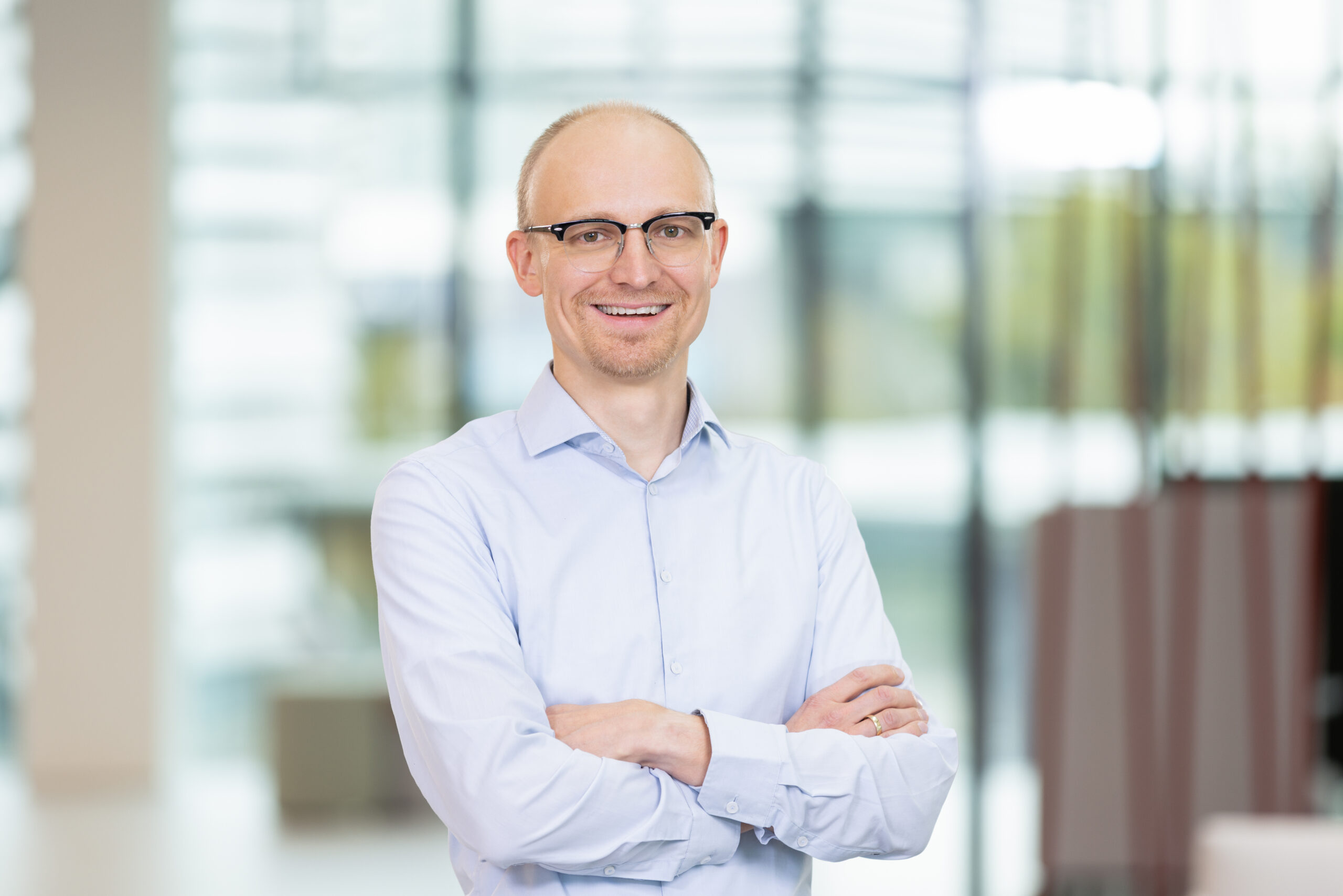
Professor Simon Steentjes, a former student of RWTH Aachen University and the current holder of the Chair of Electrical Machines and Drives ©Christian Schneider
Professor Simon Steentjes returned to his academic roots in October 2024 to become holder of the Chair of Electrical Machines and Drives.
The 37-year-old professor’s passion for technology was cultivated during his childhood, and led him to RWTH Aachen University for the first time in 2006. Here, he successfully completed his studies in Electrical Engineering and Information Technology, subsequently earning his doctorate under the supervision of his predecessor, Professor Kay Hameyer.
„I learned from an early age to repair things instead of throwing them away. My father showed me everything as a child. We often tinkered until things worked again,” recalls Professor Steentjes.
It was these formative experiences that not only ignited his enthusiasm for technology, but also instilled in him a strong commitment to sustainability.
„I want to leave behind a world worth living in for my child and future generations; thus, I consider sustainable development within electric machines and drives absolutely essential,” states the electrical engineer.
Electrical machines are indispensable for numerous applications – from industrial facilities, mobility solutions, and household appliances to energy supply systems. As such, enhancing the efficiency of electric machines and drives represents a significant opportunity for reducing CO₂ emissions – a crucial step toward protecting our climate, according to Steentje. He emphasizes that ongoing research and innovation are essential to enhance power density, torque density, efficiency levels, and manufacturing techniques while maintaining resource efficiency when integrating new technologies. Steentjes believes that we also need to gain a deeper understanding of the materials and resources used to manufacture our electrical machines to optimize their sustainability and efficiency. The use and production of magnetic materials alone – integral components found within every electrical machine – offers vast potential for optimization that must first be thoroughly understood by researchers like himself.
„To date, little attention has been paid to the advances made by the various disciplines involved or to specific components. While manufacturing technology evolves rapidly, these advancements must also inform production methods and design choices surrounding electric machines to harness opportunities for improved efficiency fully,“ the engineer points out.
Simon Steentjes is a researcher through and through. He relishes engaging with fellow researchers on pressing questions while finding solutions collaboratively, often alongside students and doctoral candidates – a dynamic he finds immensely rewarding. For him, working with young minds means fostering fresh ideas that keep him on the cutting edge. He finds it wonderful to be back in teaching.
The electrical engineer returned to academia having worked in industry before. At Audi, he was actively involved in e-mobility from the very beginning. Later, at Hilti, he took on the role of head of electric motors and drive technology in 2022, leading the development of a new electric motor platform for power tools, from concept to mass production, among other initiatives. During this time, Professor Steentjes experienced how crucial practical feedback is for designing and developing electrical machines, particularly in addressing the needs and challenges inherent of series production.
During his time in industry, he supervised around 20 doctoral theses. Publishing scientific work remained a priority for him despite his time away from academia – a clear indication that he always intended to return. Steentjes considers himself lucky to have turned his hobby into a career. He believes it’s important to do what makes you happy. And it is this attitude that he passes on to his students:
„As a professor, you have a responsibility to equip the next generation with knowledge, to motivate and encourage them to trust in their own abilities.“
He has now found his way back to academia. His return means also a personal success: Returning to RWTH Aachen University was a very personal mission for him, which he worked towards with the help of his family. The support of his family is particularly important to the husband and father. And when he’s not researching new electrical machines or drives, he likes to work with his son on motorising Lego vehicles.
Who run the work? – Team ÜEW
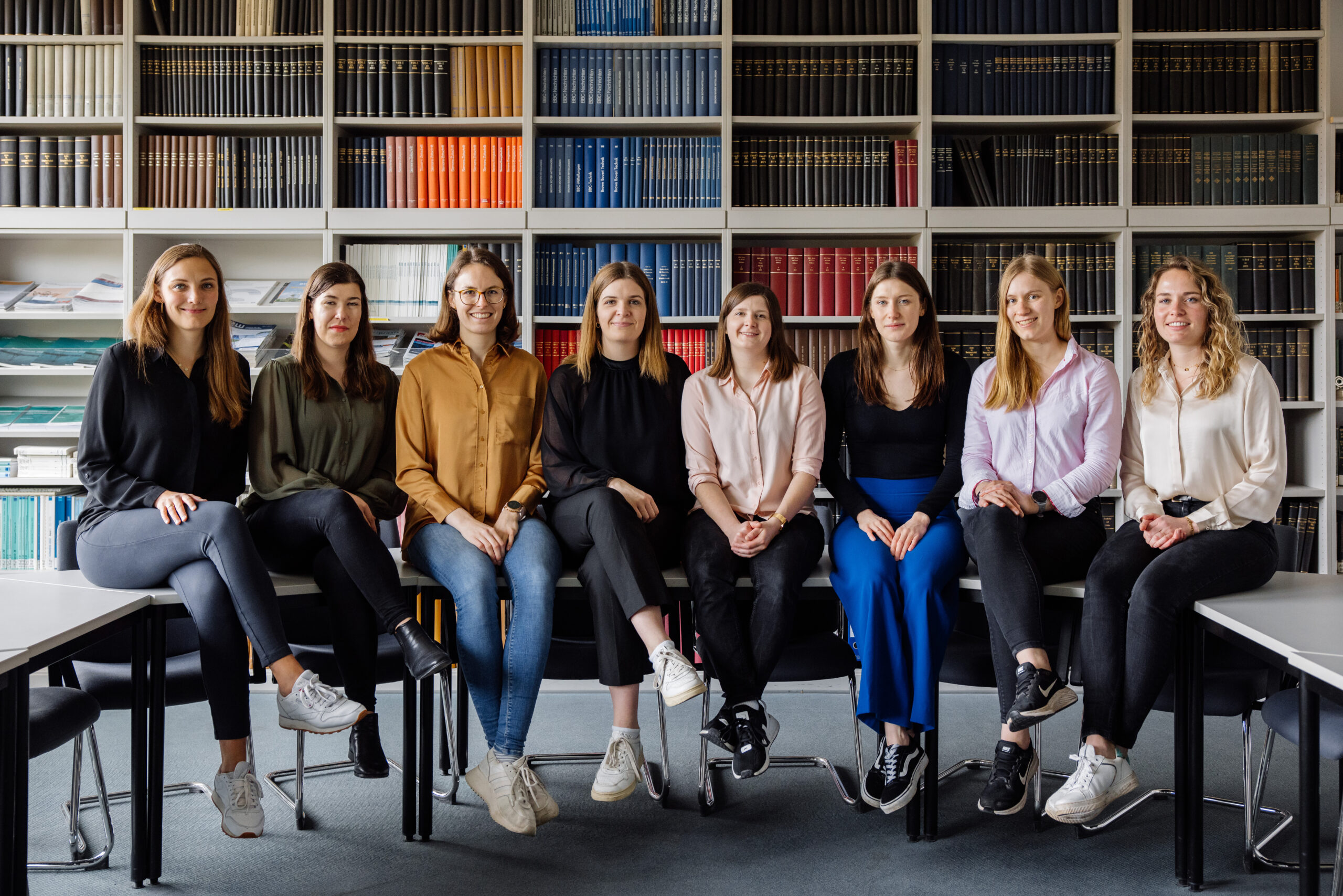
From left: Stefanie Samaan, Ricarda Kriete, Carolin Guntermann, Sophia Tepe, Lina Fischer, Muriel Krüger, Jana Einsiedle, Claire Lambriex ©Martin Braun
A look at the team from the chair of Transmission Grids and Energy Economics at the Institute of High Voltage Equipment and Grids, Digitalization and Energy Economics (IAEW) presents a pleasing picture for the field of electrical engineering: almost a third of its researchers are female.
The share of women in engineering has increased in recent years, and female engineers are a natural part of an institute team. All of the female researchers in the team have completed a degree in the field of electrical engineering and then decided to complete a doctorate at the university and start their professional career here. Of course, working in electrical engineering requires a certain interest in science and technology, but the key to success and fun is usually the curiosity to understand new things.
We are always motivated by the question: ‘How does this work?’, says Lina Fischer, who is researching a robust planning model for the future energy system.
The next step is simply to have the bravery to actively pursue these questions – even if it means venturing into the unknown.
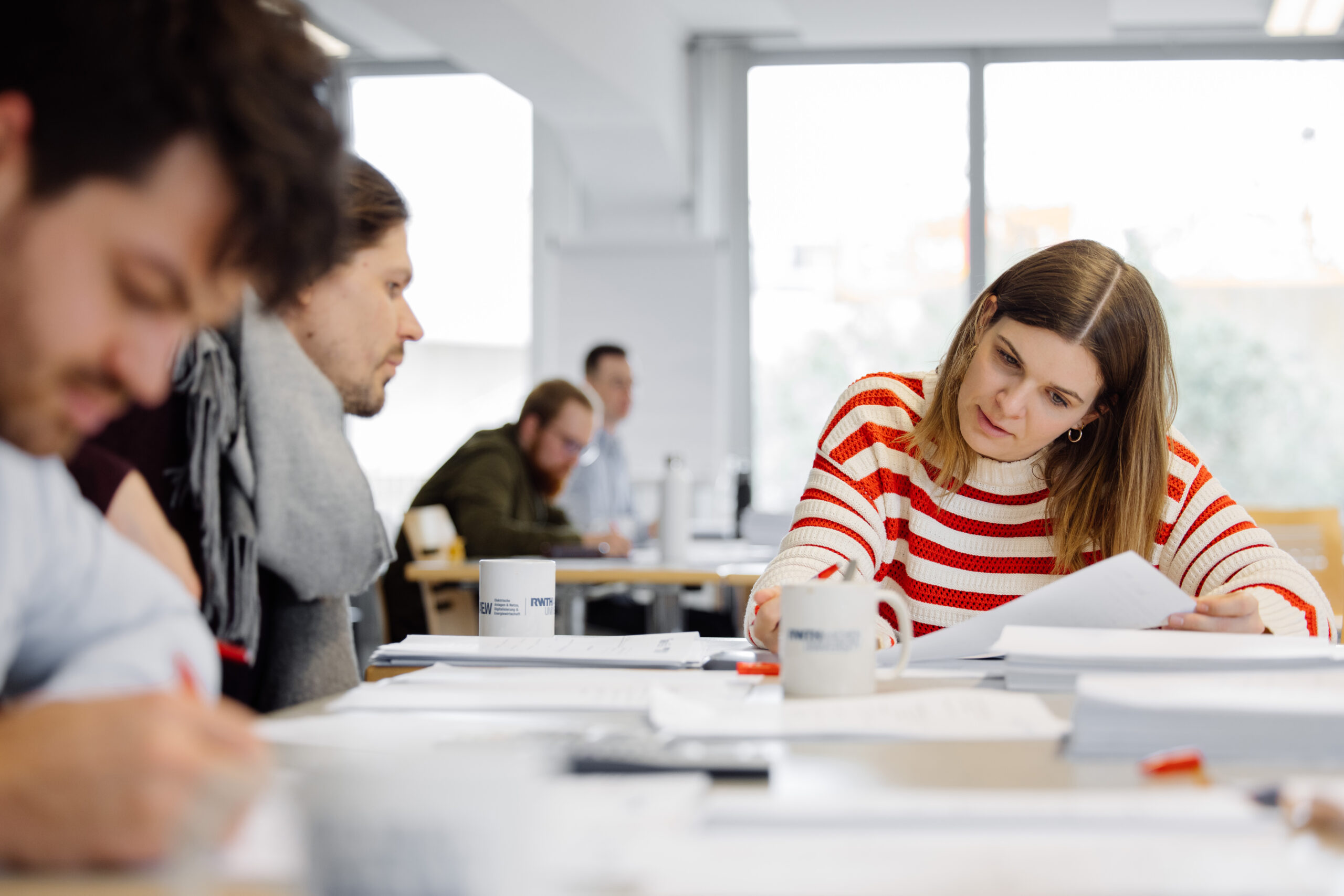
© Martin Braun
Everyone at the IAEW is driven by the vision of researching and developing solutions for the energy transition. The work at the chair of Transmission Grids and Energy Economics is primarily focusing the question:
„How should we design the future energy system so that it is environmentally friendly, reliable and economically efficient?“
This covers a wide range of interesting aspects. For example, lot of research is done on how the large amounts of energy from photovoltaic and wind energy plants, as well as alternative energy sources such as hydrogen, can be integrated into the current energy system. The transmission grid for electricity is essential for this. It can be seen in everyday life, for example, by the high-voltage power lines running alongside the freeways. The transmission grid enables electricity transport over long distances and thus the transport of large amounts of energy from wind turbines in northern Germany to regions with high electricity consumption. Current projects at the chair are investigating how the transmission grid needs to be expanded and operated in the future in order to facilitate the energy transition. Research is also ongoing in determining the locations where power lines to offshore wind turbines in the North and Baltic Seas should be connected to the grid or where large electrolysis plants for the production of hydrogen should be positioned. In addition to the technical aspects of the components, these studies must also take economic aspects into account, such as the costs arising from investments or possible congestions in the transmission grid.
In general, the consideration of economic and market aspects plays a major role in the transformation of the energy system. European efforts to further strengthen electricity trading between the individual countries are leading to increasing electricity exchanges in Europe and thus to further challenges for the transmission grid. The chair is therefore developing methods and models to simulate the European electricity markets. In this way, various future developments can be examined and their potential impact on market participants and the transmission grid can be analyzed.
A further focus of the chair is to deal with innovative concepts that will ensure the secure and reliable operation of transmission grids in the future and thus protect against blackouts. To this end, models and processes must be developed that can represent and investigate the dynamic system behavior of transmission grids and their components under changing conditions.
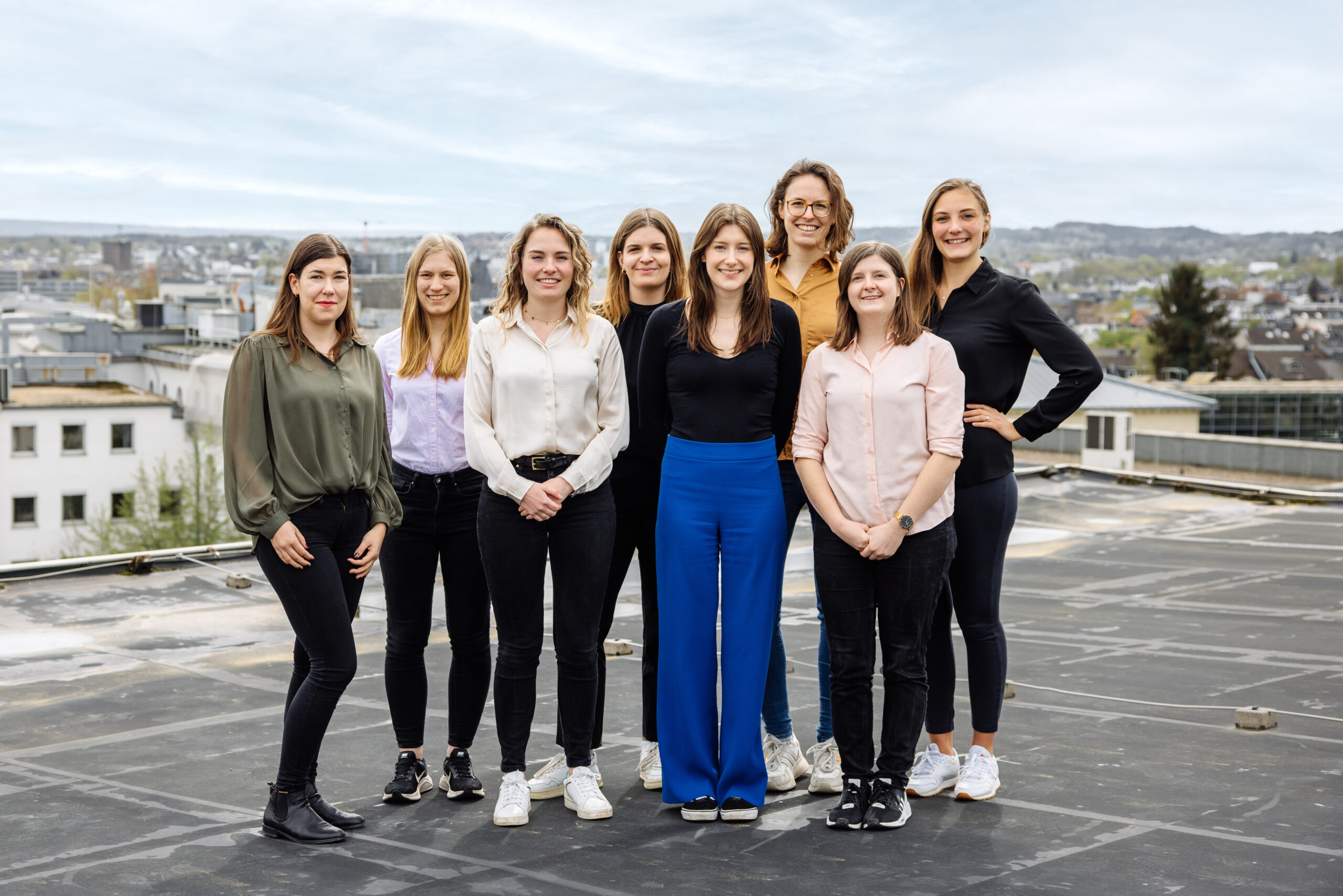
© Martin Braun
When you think of working at a university institute, your first thoughts usually revolve around working solely on your own research project. This often gives a false impression of work life at an institute, especially in the field of engineering. Work at the IAEW is characterized above all by the variety of different projects with both research and industrial partners. This allows you to get to know different topics and to gain a wide range of experience. You are often involved from the very beginning of the projects through working on them on to the presentation of the results. The different project teams make the collaboration very varied. In addition to scientific knowledge, your time at the institute gives you the opportunity to acquire a range of skills that qualify you for management positions in the industry.
Of course, you also experience many other things that make working at the institute worthwhile.
“In particular, the joint activities with other young colleagues after work, various institute traditions, parties and sporting events are all part of it.”
Notably, the IAEW also offers the opportunity to gain insight into the institute and its research topics through student assistant jobs or a thesis.
Be inspired and find your own way!
On our website we inform you about our study programmes.
Welcome to my work – Interview with Rebecca Rodrigo
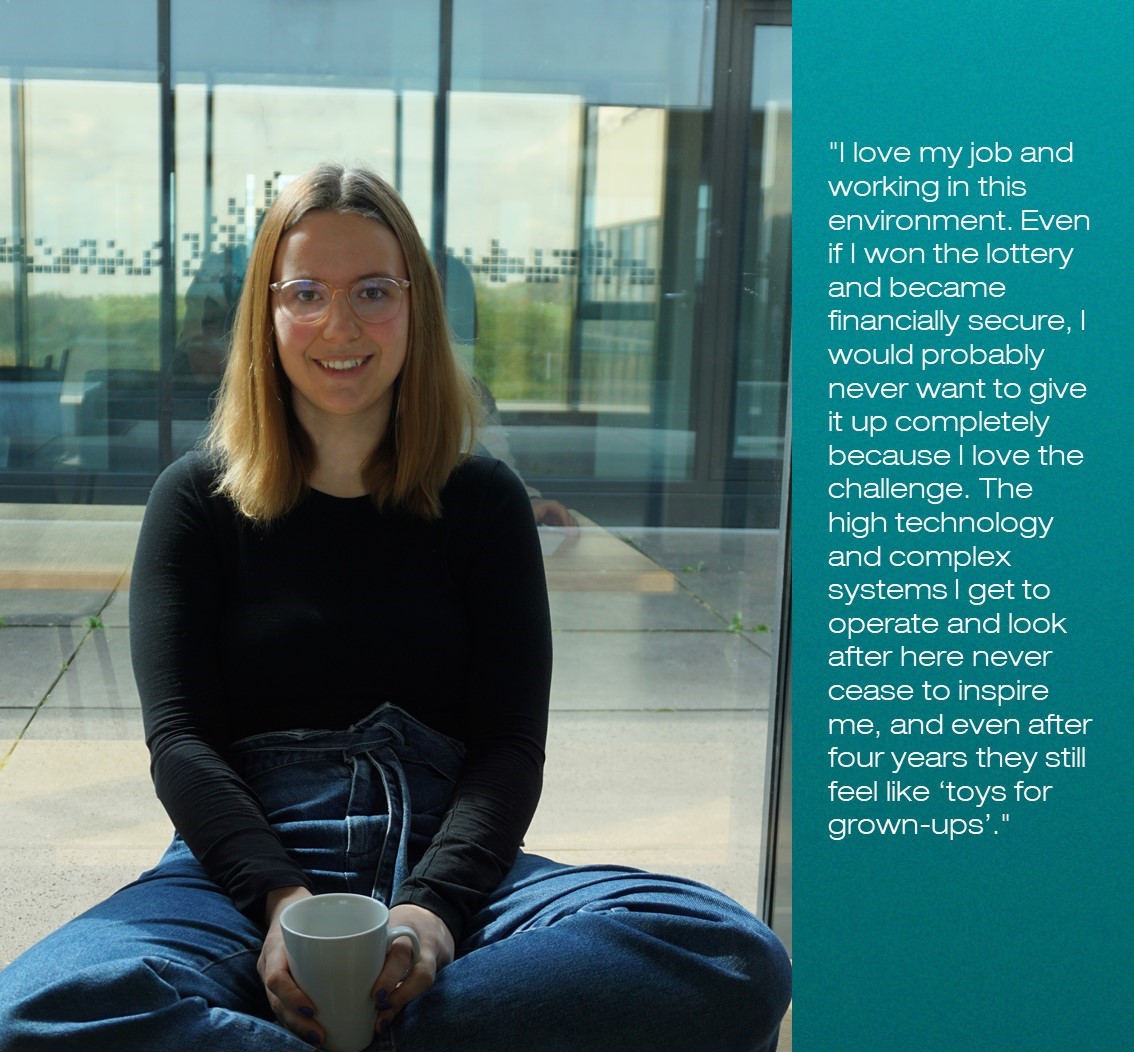
Fast, faster, the speed of light – a characteristic of modern data communication and the reason why a physicist found her way into the electrical engineering world.
Rebecca is a physicist and has been working as a cleanroom engineer at the Institute of Integrated Photonics at RWTH Aachen University since 2020. Here she gives an exclusive insight into her everyday working life.
Career guidance is often a challenge for school students. Rebecca, how did you find your way?
“Even in primary school I was very interested and enthusiastic about STEM subjects. Thanks to a dedicated and motivated physics teacher at secondary school, I decided to study physics instead of maths and physics as a teacher. I wanted to keep my options open for the future. I ‘fell in love’ with research during my bachelor’s thesis and have stayed with it ever since.”
Photonics is the technical mastery of light, which has many fascinating properties. What is photonic-electronic integration?
“Most people are familiar with electronic microchips. Integrated photonics is now concerned with implementing these functionalities on photonic microchips, where photonic signals are carried, manipulated and measured instead of electrical signals. The two microchips can also be combined or integrated to take advantage of the best features of both technologies.”
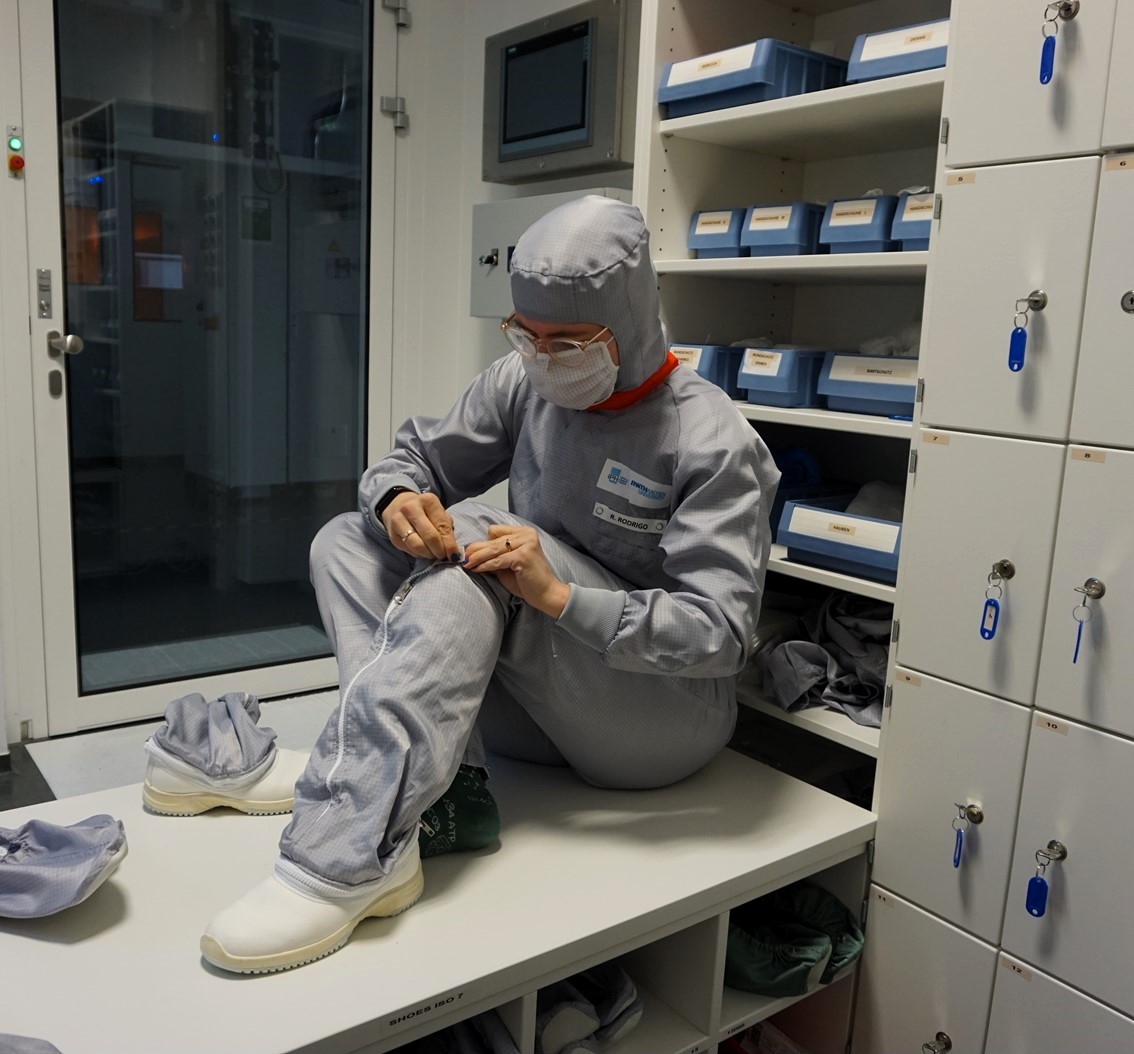
A personnel airlock leads into the cleanroom. Rebecca wears abrasion-resistant clothing to protect the ultra-sensitive microchips.
The cleanroom provides a controlled environment for specialised manufacturing processes such as the production of photonic integrated circuits on computer chips. What conditions are required in the cleanroom and why?
“The extremely low-particle environment is obviously very important, because even the smallest dust particle that gets on a microchip during the manufacturing process can affect its functionality. In our cleanroom, for example, we have only 100,000 particles larger than 0.1 micrometres per cubic metre, compared to 150 to 1000 times more in normal ambient air. The relative humidity and temperature in the cleanroom are also strictly monitored and kept constant, as the chip manufacturing processes are very sensitive.”
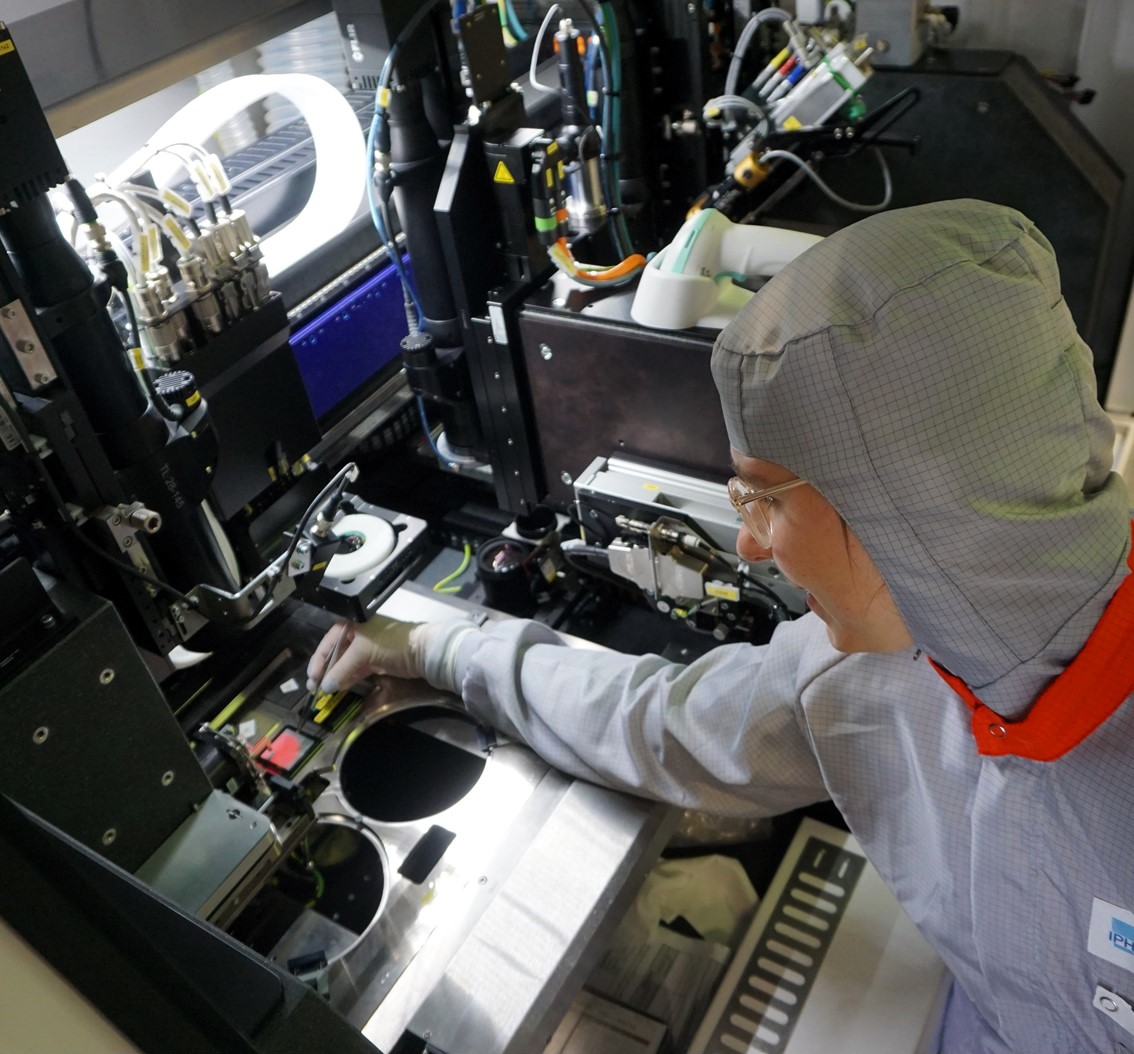
Rebecca works on the die-bonder using flip-chip technology: for chips to work properly, they need to be assembled and interconnected. The design and manufacture of these connections is known as packaging.
Photonic-electronic integration is a key technology for digitalisation. It meets the challenge of transporting and processing more and more data as we move towards a new information society. How exactly does this technology contribute to the solution?
“Most people are familiar with fibre optic technology from everyday life. Its advantages in data transmission lie primarily in its speed, but also in its energy efficiency compared to copper technology. We use the same principle, just miniaturised on a chip. It is no longer called fibre optics, but waveguides – but the basic principle is the same!
The advantage of photonics in data communications, whether over long distances as fibre-optic cables or miniaturised in chips for data centres, is therefore speed: we are unlikely to go faster than the speed of light in the foreseeable future. Parallelisation is also a clear advantage: different signals can be transmitted in parallel at different wavelengths or polarisations.”
What groundbreaking developments is the Institute of Integrated Photonics involved in? Which projects are you especially excited about?
“We have a lot of exciting projects and my role has the advantage that I am basically involved in all of them. There are certainly two projects that are particularly exciting in terms of these future technologies.
In the ML4Q cluster, we are involved in the development of a quantum computer. Many people are probably aware of the importance of this technology, for example in the field of quantum cryptography and supercomputing. Our specific task in this project is to realise a highly efficient photonic interface between spin qubits.
In the NeuroSys cluster, the IPH is working on a physical neural network based on photonic neurons. It is therefore a photonic AI. However, due to the size of such neural networks integrated on chips, it is not so much an AI like Chat GPT, but rather highly specialised and trained networks that score points in data centres for their enormous speed.”
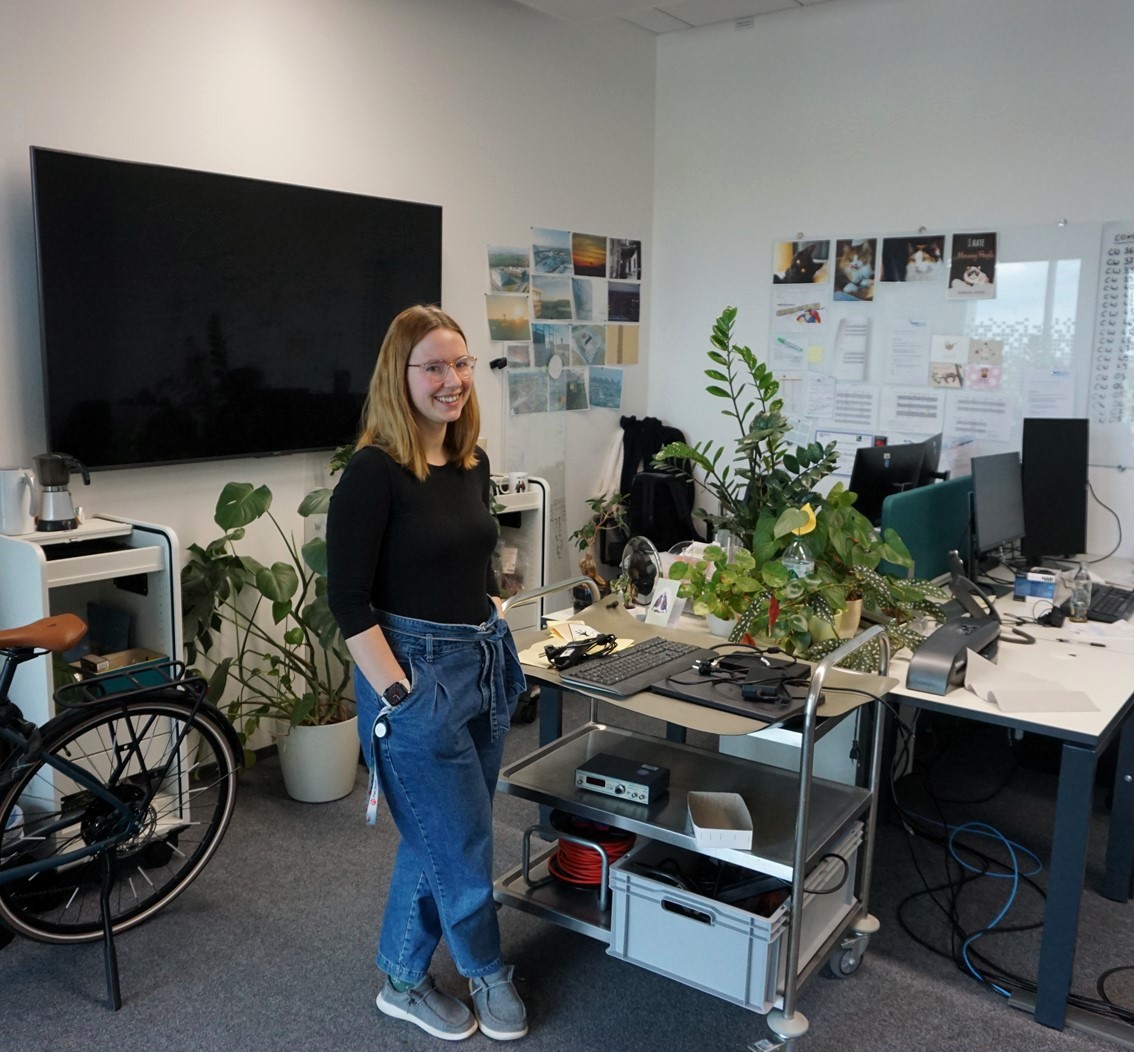
Rebecca’s office is a space for dynamic workflows and creative ideas.
What is your typical working day like?
“On a day-to-day basis, I sometimes work very application-oriented directly in chip production on the systems and also train other employees in the application. At the same time, a large part of my work consists of designing new production processes, advising my colleagues as an expert in clean room technology, scientific research and coordinating a lot of maintenance work, for example. I also have management responsibility for my small cleanroom team, which consists of one permanent employee and several students. Supervision of final theses is also part of my job.”
What does work-life balance mean to you?
“Work-life balance is very important to me. For me personally, it is really about balance. Last autumn, I had the privilege of becoming a mother to a beautiful little girl who is, of course, my world. Together with my partner, we have decided to share caring and paid work 50:50. For me, this is the perfect solution and the best of both worlds: playing and exploring with my daughter is great fun and keeps me grounded, while my job helps me to get out of the baby bubble and focus on intellectual issues.”
Are you in the process of career exploration? Stay tuned and be inspired by further insights into the working life of academics at RWTH Aachen University. Visit our website and find out more about our degree programmes.
Encouraging women to take up MINT professions – support for ZDF heute journal
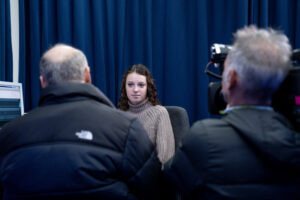
BA student Helena in an interview with the ZDF heute journal team. Photo: C. Antweiler
At the end of January, the team from ZDF heute journal visited the Institute for Communication Systems at RWTH Aachen University for a report. The report provides insights into the topic of “women in MINT subjects”, which are sometimes chosen even less by women and girls, such as mathematics, computer science, natural science and technology. Editor Peter Böhmer from the North Rhine-Westphalia State Studio researched the reasons for the low quota of women at RWTH Aachen University and what approaches could be taken to change this.
Through interviews with various female RWTH students, including our BA student Helena, as well as with Univ. Prof. Dr. rer. nat. Aloys Krieg, Prorector for Teaching, the heute journal team was able to gain an impression. The Institute for Communication Systems and a lecture by Prof. Peter Jax provided the pictorial framework for the report.
You can find the report in the ZDF Mediathek.





